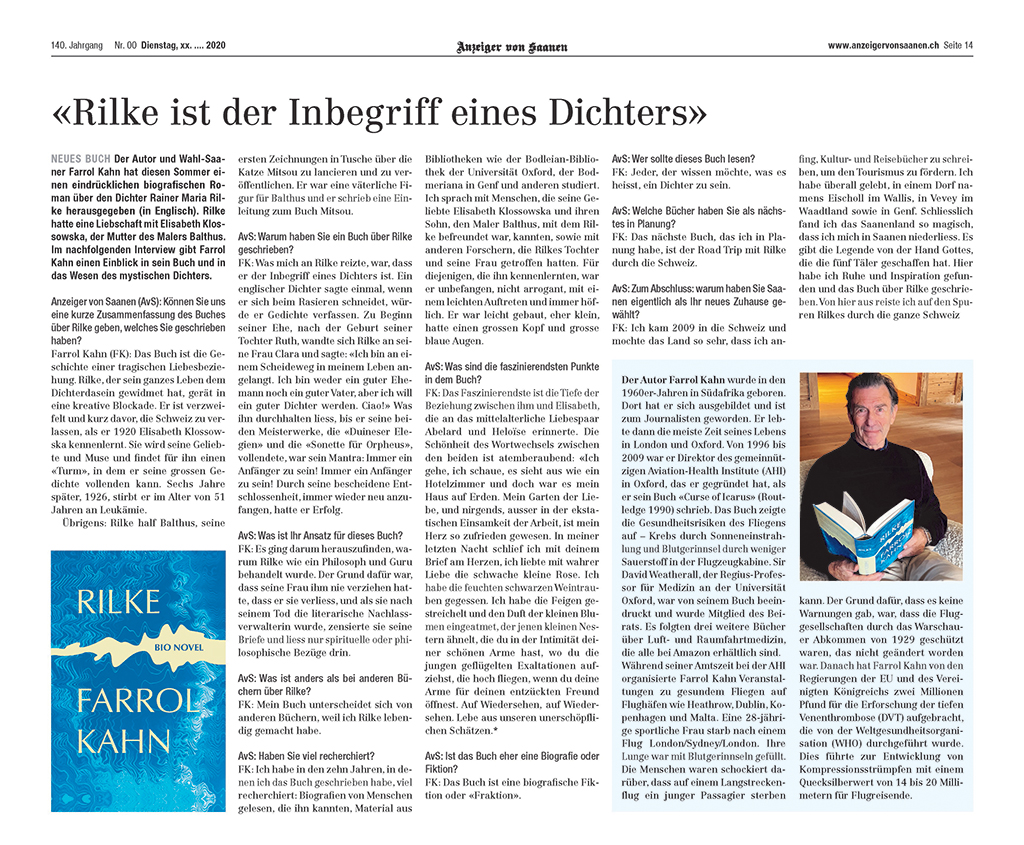The German article is below (zoom in to read) with English translation below.

Why did you write a book about Rilke?
What attracted me to Rilke was that he was the epitome of a poet. The English poet, Stephen Spender once said that if he cuts himself while shaving he will bleed poetry. At the beginning of his marriage, after the birth of his daughter Ruth, Rilke turned to his wife Clara and said: “I have come to a crossroads in my life. I am neither a good husband nor a good father, but I want to be a good poet. Ciao! ” What kept him going until he completed his two masterpieces, the “Duineser Elegies” and the “Sonnets for Orpheus”, was his mantra: “Always be a beginner! Always be a beginner! ” His modest determination to start over and over again made him successful.
What is your approach to this book?
The aim was to find out why Rilke was treated like a philosopher and guru. The reason for this was that his wife had never forgiven him for leaving her, and when she became the literary administrator of the estate after his death, she censored his letters, leaving only spiritual or philosophical references in them.
What is different from other books about Rilke?
My book differs from other books because I brought Rilke to life in a novel.
Have you done a lot of research?
I’ve done a lot of research in the ten years I’ve written the book: reading the biographies of people who knew him, studying material from libraries like the Bodleian Library at Oxford University, the Bodmeriana in Geneva, and others. I spoke to people who had known his lover Elisabeth Klossowska and her son, the painter Balthus, with whom Rilke was friends, as well as to other researchers who had met Rilke’s daughter and his wife. For those who met him, he was impartial, not arrogant, with an easy demeanor and always polite. He was slightly built, rather small, with a large head and large blue eyes.
What are the most fascinating points in the book?
The most fascinating thing is the depth of the relationship between him and Elisabeth, which is reminiscent of the medieval lovers Abelard and HeloÏse. The beauty of the exchange between the two is breathtaking: “I go, I look, it looks like a hotel room and yet it was my house on earth. My garden of love, and nowhere, except in the ecstatic solitude of work, has my heart been so satisfied. On my last night I slept with your letter on my heart, I loved the faint little rose with true love. I ate the damp black grapes. I caressed the figs and inhaled the scent of the little flowers, which resembles those little nests you have in the intimacy of your beautiful arms, where you raise the young winged exaltations that fly high when you open your arms to your delighted friend . Goodbye Goodbye. Live from our inexhaustible treasures.“
Is the book more of a biography or a fiction?
The book is a biographical fiction or “faction”.
Who Should Read This Book?
Anyone who wants to know what it means to be a poet.
What books do you have next?
The next book I’m planning is the road trip with Rilke through Switzerland.
Finally: Why did you choose Saanen as your home?
I came to Switzerland in 2009 and liked the country so much that I started writing culture and travel books to promote tourism. I’ve lived everywhere, in a village called Eischoll in Valais, in Vevey in Vaud and in Geneva. In the end I found Gstaad in Saanenland so magical that I settled there.
«The author Farrol Kahn was born in South Africa in the 1960s. There he trained and became a journalist. He then lived in London and Oxford for most of his life. From 1996 to 2009 he was director of the non-profit Aviation Health Institute (AHI) in Oxford, which he founded when he was writing his book “Curse of Icarus” (Routledge 1990). The book highlighted the health risks of flying – cancer from sun exposure and blood clots from less oxygen in the aircraft cabin. Sir David Weatherall, Regius Professor of Medicine at Oxford University, was impressed with his book and became a member of the Advisory Board. Three more books on aerospace medicine followed, all of which are available on Amazon.
During his tenure at AHI, Farrol Kahn organized healthy flying events at airports such as Heathrow, Dublin, Copenhagen and Malta. A 28 year old athletic woman died after a flight London / Sydney / London. Her lungs were filled with blood clots. People were shocked that a young passenger could die on a long-haul flight. The reason for this is that there were no warnings that the airlines were protected by the Warsaw Convention of 1929, which had not been changed. Subsequently, Farrol Kahn received £2 million from the governments of the EU and the UK for research into deep vein thrombosis (DVT) carried out by the World Health Organization (WHO). This led to the development of compression stockings with a mercury value of 14 to 20 millimeters for air travelers.
